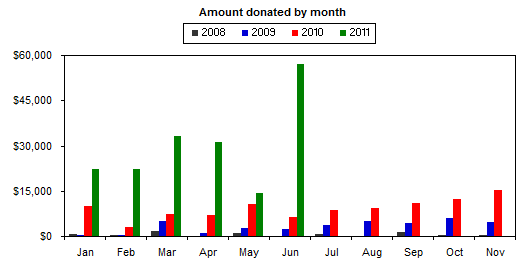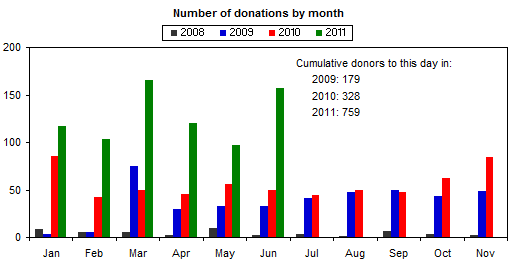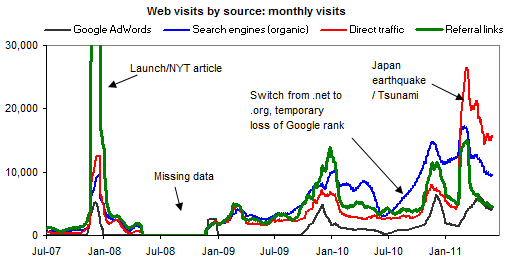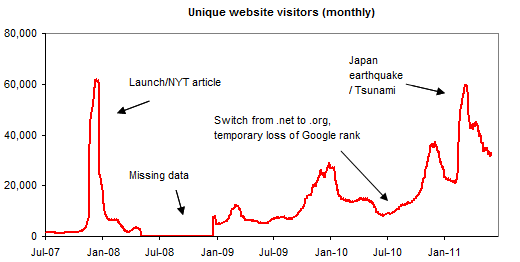Note: we sent GiveDirectly an early draft of this post and have made modifications after some back-and-forth.
We’ve been interested for a long time in the idea of simply giving out cash to the very poor, as a promising form of charity, and we’ve long been puzzled over why there don’t seem to be any charities focusing on this approach. In 2009, while acknowledging the potential drawbacks of cash transfers, we argued:
Which would you bet on to get water to people in Kenya: an organization funded by wealthy Americans (motivated by guilt and the wish to display generosity, among other things), or an organization funded by Kenyan customers (motivated by a need for water)?
Why do cash handouts seem to be so rare in the charity world? Perhaps it’s because extensive experience and study have shown this approach to be inferior to others. Or perhaps it has more to do with the fact that giving out cash fundamentally puts the people, rather than the charity, in control.
As of a few weeks ago, there is a charity focused on cash transfers: GiveDirectly. GiveDirectly plans to use the M-PESA system to transfer money using SIM cards, and hopes to give out 90% of its total expenses as cash transfers.
We encountered this group – and had some back-and-forth – before its launch.
GiveDirectly is a new organization and we have not done full due diligence on it: this is not a review. This post simply gives preliminary thoughts on a charity we consider to be worth watching. We have some concerns (see below) and the organization is too new for us to be able to assess these concerns and its general track record. That said, we think it’s worth noting a few things that stand out about GiveDirectly relative to other charities at this preliminary stage, and that we consider to be good examples of the sort of thing we’re looking for and trying to encourage. Most of these revolve around the idea of putting one’s plans on the record so one can be held accountable in the future.
Reasons to be optimistic
- GiveDirectly has committed to a clear and exclusive focus on a promising intervention. It’s our view that cash transfers ought to be considered the “starting point” for charity: if we had no evidence about the effectiveness of any intervention, cash transfers would be the one we’d support because it most directly empowers low-income people. GiveDirectly states that there is also a substantial case in the literature that cash transfers are helpful, and it’s our impression that this is true (though our investigation of this literature is still in progress and we have not reviewed GiveDirectly’s page on the matter).
We do think there are some interventions (for example, health programs) with a strong enough track record that it’s reasonable to bet on them over cash transfers. But we’re glad to see donors’ options increasing, especially when the new option is one of the most intuitive ways of helping.
- GiveDirectly makes clear and specific statements related to room for more funding, i.e., the impact of marginal (as opposed to average) donations. It has committed to give away 90% of received funds as cash transfers and has provided documents for us (see below) regarding how much funding it has the capacity for. Along these lines, we like its statement on transparency:
To us transparency means more than publishing financial statements. That tells you how we used money last year; real transparency means a clear commitment to how we will use the next dollar you give. It means focusing on providing one, easy-to-understand service; explaining exactly what it costs to provide that service; and doing so without vague language like “overhead” and “program expenses.”
- Not only is GiveDirectly conducting a randomized controlled trial; it has pre-announced the design of the study. GiveDirectly appears relatively convinced of the merits of cash transfers (see above) but is still conducting a major study to examine the impact of its own work and see whether some versions of the program are more successful than others.
Our #1 suggestion for making social science research more credible is to “pre-register it,” i.e., announce in advance what data will be collected and how it is intended to be analyzed, so that the final result can be compared with the initial plan and a reader can form their view of whether the results are an artifact of publication bias. We made this case to GiveDirectly and it sent us (see below) a template for the full survey it will be using and a plan for analyzing the data. Now that we have seen these and posted them publicly, GiveDirectly won’t be able to cherry-pick results in the same way that we suspect many studies do. (Of course it will still be possible for the researchers to perform different analysis than they had originally planned; but they won’t be able to sweep any unfavorable conclusions of their analysis under the rug.)
These are major points in GiveDirectly’s favor. We do have some concerns.
Our reservations
- GiveDirectly is a new organization and does not yet have a track record. Its work could end up failing for many reasons – political, cultural, logistical – and right now its plans for monitoring, evaluation and transparency are just that, plans. We will become much more confident in GiveDirectly if it executes over the next couple of years, succeeds in meeting its commitment of 90% of expenses given out as cash, and continues to self-monitor and publish its data.
(From GiveDirectly’s response on this point: “What readers should know about potential risks is that (a) while our organization is new, cash transfers are not (see discussion of conflict risk below); (b) we locate recipients prior to accepting donations, so there is little risk of our being unable to electronically transmit a donation; (c) we are therefore able to send 90% of donations to the poor as a commitment, not as a target, and would refund donations if we were unable to follow through.”)
- We’re uneasy about the idea of giving out cash, transparently, to some people and not others within a community. Incitement of jealousy and conflict seems possible, and if power dynamics are imbalanced enough, we’re worried that more powerful village members may take the benefits away from others. We’ve discussed these concerns with GiveDirectly, and it appears they have taken some reasonable measures to put themselves in a position to assess the extent to which this becomes a problem, but we remain uneasy at the moment.
(From GiveDirectly’s response on this point: “targeted cash transfers per se are not a new thing by any means, but in fact one of the most widely used and evaluated development interventions … cash transfers now cover between 750 million and 1 billion people worldwide (p. 10) and are one of most researched and evaluated form of development intervention (p. 30), though they remain uncommon in the charity world … What donors should know about us specifically is that we include detailed questions on conflict in our follow up surveys and also as part of our ongoing, independent impact evaluation, which will assess whether transfers increase serious conflicts (such as crime). In the follow up interviews we have conducted to date, we have learned that some people have complained about GiveDirectly because they did not receive a transfer, but we have not learned of any conflict between community members.”)
- We wouldn’t be comfortable with GiveDirectly raising as much money as its stated capacity. In discussing room for more funding with GiveDirectly, we asked for a statement of the maximum amount that could be given out as (90%) cash grants in the short term. They responded:
If one supervisor can add enough capacity each month to handle $0.5M for 4 years, or a total of $2M, then $2M per month is an upper bound on our capacity with a single supervisor (i.e. Jeremy). Based on that I’d say I’d start to worry if we were pulling in more than $20M per year — where by “worry” I mean hire more supervisors. I’ll be frank and say I don’t have an objective assessment of how many of these we can readily get our hands on; I don’t think 5 would be hard but I suspect 25 (to get us to $500M annual capacity) would.
While GiveDirectly’s analysis is logical, we just wouldn’t be comfortable seeing a charity this new and unestablished raise more than a few million dollars (serving several thousand people at $500 per year) over the short term – the risks of poorly spending (or harmfully spending) those funds if its model hit unforeseen challenges would be too great.
(From GiveDirectly’s response on this point: “Given that cash transfers have received arguably more extensive scrutiny than any other development intervention I think there is plenty of evidence to address such concerns, but of course readers should examine the evidence and decide for themselves.”)
Bottom line: GiveDirectly is too new for us to fully assess the concerns above, but it is definitely a charity to watch.
Attachments GiveDirectly has sent us:




